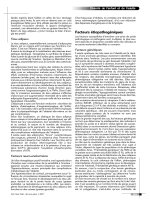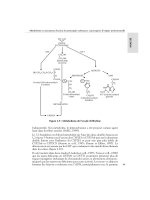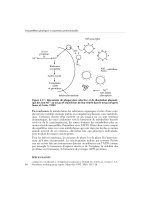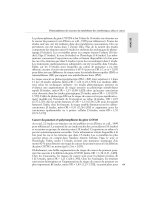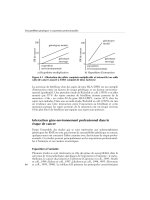Susceptibilités génétiques et expositions professionnelles - part 5 doc
Bạn đang xem bản rút gọn của tài liệu. Xem và tải ngay bản đầy đủ của tài liệu tại đây (258.48 KB, 15 trang )
En conclusion,lemétabolisme des substances organiques s’avère d’une com-
plexité très variable, mettant parfois en compétition plusieurs voies métaboli-
ques. Certaines d’entre elles mettent en jeu jusqu’à six ou sept systèmes
enzymatiques, les unes conduisant vers la formation de métabolites inactifs
vis-à-vis de la cancérogénicité, les autres formant des métabolites plus ou
moins réactifs susceptibles d’interférer avec l’ADN. Il faut donc tenir compte
des équilibres entre ces voies métaboliques qui sont régis par la plus ou moins
grande activité de ces enzymes, elle-même liée aux génotypes individuels,
pour évaluer les risques cancérogènes.
Pour les dérivés minéraux, les enzymes de phase I et de phase II n’intervien-
nent qu’à titre exceptionnel. La cancérogenèse induite par certains d’entre
eux est en fait liée aux interactions directes ou indirectes sur l’ADN comme
par exemple la formation d’espèces réactives de l’oxygène, la stabilité des
protéines environnantes, la formation de pontages ADN-protéines.
B
IBLIOGRAPHIE
ADLER ID, COCHRANE J, OSTERMANN-GOLKAR S, SPOKER TR, SORSA M, VOGEL E. 1,3-
butadiene working group report. Mutat Res 1995, 330 : 101-114
NiS amorphe
AA et
protéine
N
Ni
3+
Ni
2+
Radicaux
oxygénés
ADN oxydé
Crosslinks
ADN
et protéines
hétérochromatine
pH
4 - 5
Ni
2+
+
+
+
+
+
+
+
+
+
+
+
+
+
+
+
+
-
-
-
-
-
-
-
-
-
-
-
-
-
-
-
-
-
-
-
-
-
-
-
-
NiS
Ni
3
S
2
cristallins
Ni
2+
très faible
absorption
Figure 2.17 : Mécanisme de phagocytose sélective et de dissolution plasmati-
que des ions Ni
2+
au noyau et réactifs lors de leur entrée dans le noyau (d’après
Snow et Costa, 1998)
Susceptibilitésgénétiques et expositions professionnelles
54
ALBORES A, CEBRIAN ME, CONNELLY JC, BACH EH, BRIDGE JW. Effects of arsenite on
hepatic mixed-function oxidase activity in rats. Xenobiotica 1992, 22 : 521-597
ALBORES A, KOROPATNICK J, CHERIAN MG, ZELAZOWSKI AJ. Arsenic induces and
enhances rat hepatic metallothionein production in vivo. Chem Biol Interact 1992,
85 : 124-140
APOSHIAN HV. Arsenic toxicology : does methylation of arsenic species have on
evolutionary significance. Metal Ions Biol Med 1996, 4:399-401
APOSHIAN HV. Biochemical toxicology of arsenic. Rev Biochem Toxicol 1989, 10 :
265-269
APOSHIAN HV. Enzymatic methylation of arsenic species and other new approaches to
arsenic toxicity. Ann Rev Pharmacol Toxicol 1997, 37 : 397-419
BENCKO V. Arsenic. In : Genotoxic and carcinogenic metals : environmental and
occupational occurrence and exposure. FISHBEIN L, FURST A, MEHLMAN MA, Eds.
Princeton, New Jersey ; Princeton Scientific Publishing 1986 : 87-126
BEYERSMAN D, KOSTER A. On the role of trivalent chromium in chromium genome
toxicity. Toxicol Environ Chem
1987, 14 : 11-22
BOND JA
. Review of the toxicology of styrene. Crit Rev Toxicol 1989, 19 : 227-249
BYCZKOWKI JZ, KULKARNI AP. Lipid peroxidation and benzo(a)pyrene derivative co-
oxygenation by environmental pollutants. Bull Environ Contam Toxicol 1990, 45 :
633-640
CERNY S, MRAZ J, KLEK J, TICHY M. Effect of ethanol on the urinary excretion of
mandelic and phenylglyoxylic acids with human exposure to styrene. Int Arch Occup
Environ Health 1990, 62 : 243-247
CHANG WC, CHEN SH, WU HL, SY S, MUROCA S, MORITA L. Cytoprotective effect of
reduced glutathione in arsenical induced endothelial cell injury. Toxicology 1991, 69 :
101-110
COHEN M, LATTA D, COOGAN T, COSTA M. The reactions of metal with nucleid acids.
In : Biological effects of heavy metals. FOULKES E, Ed. Boca Raton, Floride, CRC Press
1990 : 19-75
COMSTOCK KE, WIDERSTEN M, HAO XY, HENNER WD, MANNERVICK B. A comparison of
the enzymatic and physicochemical properties of human glutathione transferase
M4-4 and three other human mu class enzymes. Arch Biochem Biophys 1994, 311 :
487-495
CONAWAY CC, WHYSNER J, VERNA LK, WILLIAMS GM. Formaldehyde mechanistic data
and risk assessment : endogenous protection from DNA adduct formation. Pharmacol
Ther 1996, 71 : 29-55
CONCHA G, NERMELL B, VAHTER MV. Metabolism of inorganicarsenicin children with
chronic high arsenic exposure in northern Argentina. Environ Health Perspect 1998,
106 : 355-359
CONNETT PH, WETTERHAHN KE. Metabolims of the carcinogen chromate by cellular
constituents structure. Bond 1983, 54 : 93-124
Métabolisme et mécanisme d’action des principales substances cancérogènes d’origine professionnelle
55
ANALYSE
CONOLLY RB, ANDJELKOVITCH DA, CASANOVA M. Multidisciplinary iterative examina-
tion of the mechanism of formaldehyde carcinogenicity : the basis for better risks
assessment. CIIT activities, Research Triangle Park, NC, Chemical Industry Institute of
Toxicology 1995, 15 : 1-11
COSTA M, SIMMONS-HANSEN J, BEDROSSIAN CWM, BONURA J, CAPRIOLI RM. Phagocy-
tosis, cellular distribution and carcinogenic activity of particulate nickel compounds
in tissue culture. Cancer Res 1981, 41 : 2868
DE FLORA S, WETTERHAHN KE. Mechanisms of chromium metabolism and genotoxic-
ity. Life Chem Resp 1990, 2:78-84
DEATON MA, BOWMAN PD, JONES GP, POWANDA MC. Stress protein synthesis in human
keratinocytes treated with sodium arsenite, phenyldichloroarsenic and nitrogen mus-
tard. Fundam Appl Toxicol 1990, 14 : 471-476
DEWAN A, JANI JP, PATEL PS. Benzidine and its metabolites in the urine of workers
exposed to direct black 38. Arch Environ Health 1988, 43 : 269-272
DIX TA, MARNETT JL. Metabolism of polycyclic aromatic hydrocarbon derivatives to
ultimate carcinogens during lipid peroxidation. Science 1983, 221 : 77-79
EASTMOND DA, SMITH MT, IRONS RD. An interaction of benzene metabolites repro-
duces the myelotoxicity observed with benzene exposure. Toxicol Appl Pharmacol
1987, 91 : 85-95
EBERLE G, BARBIN A, LAIB RJ, CIROUSEL F, THOMALE J, BARTSCH H, RAJEWSKI MF.
1-N6-etheno-2’ deoxyadenosine and 3-N-etheno 2’ deoxycytidine detected by mono-
clonal antibodies in lung and liver DNA of rats exposed to vinyl chloride. Carcino-
genesis 1989, 13 : 209-212
FALKNER KC, MCCALLUM GP, CHERIAN MG, BEND JR. Effect of acute sodium arsenite
administration on the pulmonary chemical metabolizing enzymes, CYP 450 monoxy-
genases, NAD(P)H-quinone acceptor oxido-reductase and glutathione S-transferase
in guinea pig. Comparison with effect on liver and kidney. Chem Biol Interact 1993,
86 : 51-68
FLAMMANG TJ, YAMAZOE Y, BENSON RW. Arachidonic acid-dependent peroxidative
activation of carcinogenic arylamines by extrahepatic human tissue microsomes.
Cancer Res 1989, 49 : 1977-1982
FREDERICK CB, WEISS CC, FLAMMANG TJ, MARTIN CN, KADLUBAR FF. Hepatic
N-oxydation, acetyl-transfer and DNA binding of the acetylated metabolites of the
carcinogen benzidine. Carcinogenesis 1985, 6:956-965
GARCIA JD, JENNETTE KW. Electron transport cytochrome P450 system is involved in
the microsomal metabolism of the carcinogen chromate. J Inorg Biochem 1981, 14 :
281-295
GEORIS B, CARDENAS A, BUCHET JP, LAUWERYS R. Inorganic arsenic methylation by rat
tissue slices. Toxicology 1990, 63 : 73-84
GRANSTOM E, KUMLIN N. Metabolism of prostaglandins and lipoxygenase products :
relevance for eicosanoid assay. In : Prostaglandins and related substances. A practical
approach.
BENEDETTO RG, MC DONALD-GIBSON RG, NIGAM S, SLATER TF, Eds. Oxford,
UK, IRL Press 1987 : 5-27
Susceptibilitésgénétiques et expositions professionnelles
56
GUBITS RM, FAIRHURST JL. C-fos mRNA levels are increased by the cellular stressors,
heat block and sodium arsenite. Oncogene 1988, 3:163-168
GUENGERICH FP, GEIGER LE, HOGY LL, WRIGHT PL. In vitro metabolism of acrylonitrile
to 2-cyanoethylene oxide, reaction with glutathione, and irreversible binding to
proteins and nucleic acids. Cancer Res 1981, 41 : 51-56
GUENGERICH FP, KIM DH, IWASAKI M. Role of human cytochrome P-450 II E 1 in the
oxydation of many low molecular weight cancer suspects. Chem Res Toxicol 1991, 4:
168-169
GUY GR, CAIRNS J, NG SB, TAN YH. Inactivation of a red-ox-sensitive protein phos-
phatase during the early events of tumor necrosis factor/interleukine 1 signal trans-
duction. J Biol Chem 1993, 258 : 2141-2148
HALLIER E, LANGHOF T, DANNAPEL D, LEUTBECHER M, SCHRODER K et coll. Polymor-
phism of glutathione conjugation of methylbromide, ethylene oxide and dichlo-
romethane in blood cells : influence on the induction of sister chromatide exchanges.
Arch Toxicol 1993, 67 : 173-178
HAMILTON JW, KALTREIDER RC, BAJENOVA OV, IHNAT MA, MCCAFFREY J et coll. Mo-
lecular basis for effects of carcinogenic heavy metals on inducible gene expression.
Environ Health Perspect 1998, 106 : 1005-1015
HANSEN K, STERN RM. Toxicity and transformation of nickel compounds in vitro. In :
Nickel in the human environment.
SUNDERMAN FW, Ed. IARC Scientific Publication
1984 : 193-200
HAYES RB, WENFANG B, ROTHMAN N, BROLY F, CAPORASO N et coll. N-acetylation
phenotype and genotype and risk of bladder cancer in benzidine-exposed workers.
Carcinogenesis 1993, 14 : 675-678
HENDERSON RF. Species differences in the metabolism of benzene. Environ Health
Perspect 1996, 104 : 1173-1175
HOBSON J, WRIGHT JL, CHUNG A. Active oxygen species mediate asbestos fiber uptake
by tracheal epithelial cells. FASEB J 1990, 4:3134-3139
HUANG CY, HUANG KL, CHENG TJ, WANG JD, HSIEH LL. The GSTT1 and CYP2E1
genotypes are possible factors causing vinyl chloride induced abnormal liver function.
Arch Toxicol 1997, 71 : 482-488
HUANG RN, HO JC, YIH LH, LEE TC. Sodium arsenite induces chromosome endoreplica-
tion and inhibits protein phosphate activity in human fibroblasts. Environ Mol Mu-
tagen 1995, 25 : 188-196
HUANG X, ZHUANG ZX, FRENKEL K, KLEIN CB, COSTA M. Role of nickel and nickel-
mediated reactive oxygen species in the mechanism of nickel carcinogenesis. Environ
Health Perspect 1994, 102 : 281-284
IARC. Monographs on the evaluation of carcinogenesis risks to humans. Overall
evaluations of carcinogenicity : an updating of IARC monographs. WHO, IARC Lyon
1987, 1-42 (Suppl 7) : 373-376
IARC. Monographs on the evaluation of carcinogenic risks to humans. Chromium,
nickel and welding. IARC Lyon 1990, 40
Métabolisme et mécanisme d’action des principales substances cancérogènes d’origine professionnelle
57
ANALYSE
IARC. Monographs on the evaluation of carcinogenic risks to humans. Formaldehyde.
IARC Lyon 1995, 62 : 217-375
IARC. Monographs on the evaluation of carcinogenic risks to humans. Re-evaluation
of some organic chemicals hydrazine and hydrogen peroxide (part one). IARC Lyon
1999, 71 : 109-225
JACOBS JM, NICHOLS CE, ANDREW AS, MAREK DE, WOOD SG et coll. Effect of arsenite on
induction of CYP 1A, CYP 2B, and CYP 3A in primary cultures of rat hepatocytes.
Toxicol Appl Toxicol 1999, 157 : 51-59
JAGER JW, OSTROSKI-WEGMAN P. Arsenic : a paradoxal human carcinogen. Mutat Res
1997, 386 : 181-184
JOSEPHY PD. Activation of aromatic amines by prostaglandin H synthase. Free Rad Biol
Med 1989, 6:533-540
KANE AB, BOFFETTA P, SARACCI R, WILBURN JD. Mechanisms of fiber carcinogenesis.
IARC Scientifc Publications Lyon 1996, 140
KAWANISHI S, INOUE S, SANO S. Mechanism of DNA cleavage induced by sodium
chromate (VI) in the presence of hydrogen peroxide. J Biol Chem 1986, 261 :
5952-5958
KEDDERIS GL, BATRA R. Species differences in the hydrolysis of 2-cyanoethylene oxide,
the epoxide metabolite of acrylonitrile. Cancerogenesis 1993, 14 : 685-689
KEDDERIS GL, BATRA R, KOOP DR. Epoxidation of acrylonitrile by rat and human
cytochromes P450. Chem Res Toxicol 1993a, 6:866-871
KEDDERIS GL, SUMNER SJC, HELD SD, BATRA R, TURNER MJJ, ROBERTS AE, FENELL TR.
Dose dependent urinary excretion of acrylonitrile metabolites by rats and mice.
Toxicol Appl Pharmacol 1993b, 120 : 288-297
KEYSE SM, TYRRELL RM. Heme oxygenase is the major 32-kDa stress protein induced in
human skin fibroblasts by UV-A radiation, hydrogen peroxide and sodium arsenite.
Proc Natl Acad Sci USA 1989, 85 : 99-103
KOOP DR, LAETHEM CL, SCHNIER GG. Identification of ethanol-inducible
P450 isoenzyme 3a(P450IIE1) as a benzene and phenol hydroxylase. Toxicol Appl
Pharmacol 1989, 98 : 278-288
KRAUSE RJ, ELFARRA AA. Oxydation of butadiene monoxide to meso-and (±) diep-
oxybutane by c-DNA-expressed human cytochrome P450s and by mouse, rat and
human liver microsomes : evidence for preferential hydration of meso-diepoxybutane
in rat and human liver microsomes. Arch Biochem Biophys 1997, 337 : 176-184
LAWLEY PD. Some chemical aspects of dose-response relationships in alkylation mu-
tagenesis. Mutat Res 1974, 23 : 283-295
LAWRENCE RM, SWEETMAN GMA, TAVARES R, FARMER PB. Synthesis and characterisa-
tion of peptide adducts for use in monitoring human exposure to acrylonitrile and
ethylene oxide. Teratog Carcinog Mutag 1996, 16 : 139-148
LEE Y, KLEIN C, KARGALIN B. Carcinogenic nickel silences gene expression by chroma-
tin condensation and DNA methylation. A new model for epigenetic carcinogens.
Mol Cell Biol 1995, 15 : 2547-2557
Susceptibilitésgénétiques et expositions professionnelles
58
LI JH, BILLING PC, KENNEDY AR. Induction of oncogen expression by sodium arsenite in
C3H/10T1/2 cells : inhibition of c-myc expression by the Bowman-Berik protease
inhibitor. Cancer J 1992, 5:354-358
LI JH, ROSSMANN TG. Inhibition of DNA ligase activity by arsenite : a possible
mechanism of its comutagenesis. Mol Toxicol 1989, 2:1-9
LOPEZ S, MIYASHITA Y, SIMONS SS. Structurally based selective interaction of arsenite
with steroid receptors. J Biol Chem 1990, 265 : 16039-16042
MARAFANTE E, VATER M, ENVOI J. The role of the methylation in the detoxication of
arsenate in the rabbit. Chem Biol Interact 1985, 56 : 225-228
MATHISON BH, TAYLOR ML, BOGDANFFY MS. Dimethyl sulfate uptake and methylation
of DNA in rat respiratory tissues following acute inhalation. Fundam Appl Toxicol
1995, 28 : 255-263
MONTICELLO TM, MILLER FJ, MORGAN KT. Regional increases in rat nasalepithelial cell
proliferation following acute and subchronic inhalation of formaldehyde. Toxicol Appl
Pharmacol 1991, 111 : 409-421
MONTICELLO TM, SWENBERG JA, GROSS EA. Correlation of regional and non-linear
formaldehyde-induced nasal cancer with proliferating populations of cells. Cancer Res
1996, 56 : 1012-1022
MOSSMAN BT, EASTMAN A, LANDESMAN JM, BRESNIK E. Effects of crocidolite and
chrysotile asbestos on cellular uptake and metabolism of benzo(a)pyrene in hamster
tracheal epithelial cells. Environ Health Perspect 1983, 51 : 331-335
MÜLLER M, KRAMER A, ANGERER J, HALLIER E. Ethylene oxide-protein adduct forma-
tion in humans : influence of glutathione-S-transferase polymorphisms. Int Arch
Occup Environ Health 1998, 71 : 499-502
NAKAJIMA T, ELOVAARA E, GONZALES FJ, GELBOIN FJ, VAINO H, AYOAMA T. Character-
ization of the human cytochrome P450 isoenzymes responsible for styrene metabo-
lism. In : Butadiene and styrene : assessment of health hazards. SORSA M, PELTONEN K,
VAINO H, HEMMINKI K
, Eds. IARC Scientific Publications Lyon 1993, 127 : 101-108
NISHIO A, UYEKI EM. Inhibition of DNA synthesis by chromium compounds. J Toxicol
Environ Health 1985, 15 : 237-244
PELIN K, HIRVONEN A, TAAVITSAINEN M, LINNAINMAA K. Cytogenetic response to
asbestos fibers in cultured human primary mesothelial cells from 10 different donors.
Mut Res 1995, 334 : 225-233
PETER H, BOLT HM. Irreversible protein binding of acrylonitrile. Xenobiotica 1981, 11 :
51-56
PHILIPPS DH, FARMER PB. Evidence for DNA and protein binding by styrene and
styrene oxide. Crit Rev Toxicol 1994, 24 : S1, S35-S46
REHN L. Blasengeschwülste bei Fuchsin Arbeitern. Ark Klin Chir 1895, 50 : 588
ROGACZEWSKA T, PIOTROWSKI J. Routes of acrylonitrile absorption in man. Med Pr
1968, 19 : 349-353
ROSSI SC, GORMAN N, WETTERHAHN KE. Mitochondrial reduction of the carcinogen
chromate : formation of chromium(V). Chem Res Toxicol 1988, 1:101-107
Métabolisme et mécanisme d’action des principales substances cancérogènes d’origine professionnelle
59
ANALYSE
ROSSI SC, GORMAN N, WETTERHAHN KE. Mitochondrial reduction of the carcinogen
chromate by mitochondrial electron transport chain complexes. Carcinogenesis 1989,
10 : 913-920
ROTHMAN N, BHATNAGAR VK, HAYES RB, ZENSER TV, KASHYAP SK et coll. The impact
of interindividual variation in NAT2 activity on benzidine urinary metabolites and
urothelial DNA adducts in exposed workers. Proc Natl Acad Sci USA 1996, 93 :
5084-5089
ROTHMAN N, SMITH MT, HAYES RB, TRAVER RD, HOENER B et coll. Benzenepoisoning, a
risk factor for hematological malignancy, is associated with the NQO1 609C > T
mutation and rapid fractional excretion of chlorzoxazone. Cancer Res 1997a, 57 :
2839-2842
ROTHMAN N, TALASKA G, HAYES RB, BHATNAGAR VK, BELL DA et coll. Acidicurine pH
is associated with elevated levels of free urinary benzidine and N-acetylbenzidine and
urothelial cell DNA adducts in exposed workers. Cancer Epidemiol Biomarkers Prev
1997b, 6:1039-1042
SARDANA MK, DRUMMOND GS, SASSA S, KAPPAS A. The potent heme oxygenase
inducing action of arsenic and parisiticidal arsenicals. Pharmacology 1981, 23 : 247-
253
SAVELA K, HESSO A, HEMMINKI K. Characterization of reaction products between
styrene oxide and deoxynucleosides and DNA. Chem Biol Interact 1986, 60 : 235-246
SCIARINI LJ, MEIGS JW. The biotransformation of benzidine. II. Studies in mouse and
men. Arch Environ Health 1961, 2:423-428
SCOTT N, HATTELID KM, MCKENZIE NE, CARTER DE. Reactions of arsenic (III) and
arsenic (V) species with glutathion. Chem Res Toxicol 1993, 6:102-106
SEATON MJ, FOLLANSBEE MH, BOND JA. Oxydation of 1,2-epoxy-3-butene to
1,2,3,4 diepoxybutane by c-DNA-expressed human cytochromes P450 2E1 and 3A4
and human, mouse and rat liver microsomes. Carcinogenesis 1995, 16 : 2287-2293
SELZER RR, ELFARRA AA. Synthesis and biochemical characterization of N1-, N2-,
N7-guanosine adducts of butadiene monoxide. Chem Rev Toxicol 1996, 9:126-132
SHI X, DALAL NS. On the hydroxy radical formation between hydrogen peroxide and
biological generated chromium (V) species. Arch Biochem Biophys 1990, 277 : 342-
350
SMITH MT, YAGER JW, STEINMETZ KL, EASTMOND DA. Peroxidase-dependent metabo-
lism of benzene’s phenolic metabolites and its potential role in benzene toxicity and
carcinogenicity. Environ Health Perspect 1989, 82 : 23-29
SNOW ET, COSTA M. Nickel toxicity and carcinogenesis. In : Environmental and
occupational medicine, ROM.W.N. Lippincott-Raven, Philadelphia USA 1998 :
1057-1064
SNOW ET, XU LS. Effects of chromium (III) on DNA replication in vitro. Biol Trace Elem
Res 1989, 21 : 61-71
SNYDER R, HEDLI CC. An overview of benzene metabolism. Environ Health Perspect
1996, 104 : 1165-1171
Susceptibilitésgénétiques et expositions professionnelles
60
SORSA M, OSTERMAN-GOLKAR S, PELTONEN K, SAARIKOSKI ST, SRAM R. Assessment of
exposure to butadiene in the process industry. Toxicology 1996, 113 : 77-83
SUMMER SJ, FENNELL TR. Review of the metabolic fate of the styrene. Crit Rev Toxicol
1994, 24 : S1, S11-S33
SWENBERG JA, FEDTKE N, CIROUSEL F, BARBIN A, BARTSCH H. Etheno adducts formed in
DNA of vinyl chloride-exposed rats are highly persistent in liver. Carcinogenesis 1992,
13 : 727-729
TAN KH, MEYER DJ, COLES B, KETTERER B. Thymine hydroperoxide, a substrate for rat
Se-dependant glutathione peroxidase and glutathion transferase isoenzymes. FEBS
Lett 1986, 207 : 231-233
TITENKO-HOLLAND N, LEVINE AJ, SMITH MT. Quantification of epithelial cell micronu-
clei by fluorescence in hybridization (FISH) in mortuary science students exposed to
formaldehyde. Mutat Res 1996, 371 : 237-248
TORJUSSEN W, HAUG F, ANDERSEN I. Concentration and distribution of heavy metals
in nasal mucosa of nickel exposed workers and of controls, studied with atomic
absorption spectrometry and with Timms’ sulphide silver method. Acta Otolaryngol
1978, 86 : 449-463
UUSKULA M, JARVENTAUS H, HIRVONEN A, SORSA M, NORPPA H.Influence of GSTM1
genotype on sister chromatid exchange induction by styrene-7,8-oxide and 1,2-
epoxy-3-butene in cultured human lymphocytes. Carcinogenesis 1995, 16 : 947-950
VAN BLADEREN PJ, DELBRESSINE LPC, HOOGETERP JJ, BEAUMONT HGM, BREIMER DD et
coll. Formation of mercapturic acids from acrylonitrile, crotonitrile, and cinnamoni-
trile by direct conjugation and via an intermediate oxidation process. Drug Metabol
Disp 1981, 9:246-249
VEGA L, GONSEBLATT ME, OSTROWSKI-WEGMAN P. Aneugenic effect of sodium arsen-
ite on human lymphocytes in vitro : an individual susceptibility effect detected. Mutat
Res 1995, 334 : 365-373
WHITLOCK JP. Induction of cytochrome P450 1A1. Annu Rev Pharmacol Toxicol 1999,
39 : 103-125
WIEGAND HJ, OTTENWALDER H, SOLT HM. The reduction of chromium (VI) to chro-
mium (III) by glutathione : an intracellular redox pathway in the metabolism of the
carcinogen chromate. Toxicology 1984, 33 : 341-348
WOLF T, KASERMANN R, OTTENWALDER H. Molecular interaction of different chro-
mium species with nucleotides and nucleic acids. Carcinogenesis 1989, 10 : 655-659
WOLFS P, DUTRIEUX M, SCAILTEUR V, HAXHE JJ, ZUMOFEN M, LAUWERYS R. Monitoring
of workers exposed to ethylene oxide in a plant distributing sterilizing gases and in
units for sterilizing medical equipment. Arch Mal Prof 1983, 44 : 321-328
YANG LL, KOURI RE, CURREN RD. Xeroderma pigmentosum fibroblasts are more sensi-
tive to asbestos fibers than are normal human fibroblasts. Carcinogenesis 1984, 5:
291-294
ZALMA R, BONNEAU L, GUIGNARD J, PEZERAT H. Formation of oxyradicals by oxygen
reduction arising from the surface activity of asbestos. Can J Chem 1987, 65 :
2338-2341
Métabolisme et mécanisme d’action des principales substances cancérogènes d’origine professionnelle
61
ANALYSE
ZENSER TV, MATTAMAL MB, ARMBRECHT MJ, DAVIS BB. Benzidine binding to nucleic
acids mediated by the peroxidative activity of prostaglandine endoperoxide syn-
thetase. Cancer Res 1980, 40 : 2839-2845
ZHONG Z, TROLL W, KOENIG K, FRENKEL K. Carcinogenic sulfide salts of nickel and
cadmium induce H
2
O
2
formation by human polymorphonuclear leukocytes. Cancer
Res 1990, 50 : 5764-5770
Susceptibilitésgénétiques et expositions professionnelles
62
3
Polymorphismes des enzymes du
métabolisme des xénobiotiques,
tabac et cancer : bilan des
données épidémiologiques
Les cancers liés au tabac sont essentiellement les cancers du poumon, des voies
aéro-digestives supérieures (VADS) et de la vessie. En France, le cancer du
poumon est de loin celui qui entraîne le plus grand nombre de décès chez
l’homme (25 % des décès par cancer en 1995) ; les cancers des VADS (cavité
buccale, pharynx, larynx, œsophage) représentent 13 % des décès par cancer
et le cancer de la vessie environ 4 % (Ménégoz et Chérié-Challine, 1997).
Chez la femme, les cancers du poumon, des VADS et de la vessie représentent
respectivement 6 %,9%et2%desdécès par cancer.
À niveau égal de consommation de tabac, certains fumeurs développeront ces
types de cancers et d’autres n’en seront jamais atteints. Des facteurs génétiques
pourraient expliquer cette différence de risque vis-à-vis de l’exposition au
tabac. Certains de ces facteurs peuvent être étudiésgrâce à l’analyse du
polymorphisme de gènes codant les enzymes impliquées dans le métabolisme
des cancérogènes. Ces polymorphismes peuvent être étudiés aisément en
population par des tests de génotypage, déterminant chez un individu l’assor-
timent des allèles (génotype) du gène codant l’enzyme d’intérêt ou par des
tests de phénotypage (en mesurant l’activité enzymatique d’un individu, in
vivo grâce à l’étude pharmacocinétique de médicaments traceurs spécifiques,
ou in vitro sur les lymphocytes). Certaines difficultés sont inhérentes aux tests
de phénotypage : en particulier, l’activité enzymatique peut être modifiée par
la prise concomitante de médicaments faisant intervenir dans leur métabo-
lisme la même enzyme que celle impliquée dans celui du médicament traceur,
ou par des difficultés expérimentales pour les tests in vitro. Plusieurs polymor-
phismes génétiques sont à l’heure actuelle bien identifiés et leurs effets sur les
risques de cancer ont fait l’objet d’un certain nombre d’études épidémiologi-
ques.
63
ANALYSE
Polymorphismes génétiques et cancers liés au tabac
Les associations potentielles entre certains cancers et les polymorphismes
génétiques des cytochromes P450 CYP1A1, 1A2, 2D6 et 2E1, des glutathion
S-transférases GSTM1 et GSTT1, et des N-acétyltransférases NAT1 et NAT2
ont été récemment évaluées dans une monographie scientifique du Centre
international de recherche sur le cancer (d’Errico et coll., 1999). Pour chaque
association, les auteurs ont effectué une méta-analyse des études épidémiolo-
giques publiées jusqu’en mai 1997, basée sur des odds ratio (OR) publiésou
recalculés à partir des données de chaque étude. L’association entre un poly-
morphisme spécifique et une localisation de cancer, évaluée en combinant
l’ensemble des études, est exprimée par un « méta-OR » et un intervalle de
confiance à 95 %. Les caractéristiques des études cas-témoins évaluant les
associations entre ces polymorphismes et les cancers du poumon, de la vessie
et du larynx (cancers les plus fréquemment étudiés) sont présentées dans les
tableaux 3.I à 3.III.
Cancer du poumon et polymorphisme du gène CYP1A1
La prévalence du polymorphisme MspI (présent dans les allèles CYP1A1*2A
et CYP1A1*2B)diffère selon les populations : chez les Asiatiques, environ
10 % des individus sont homozygotes pour l’allèle variant ou allèle modifié
(MM) et 40 % sont hétérozygotes, alors que ces fréquences sont respective-
ment d’environ 0,5-5 % et 20 % dans les autres populations. Les risques de
cancer du poumon ont donc été estimés pour les homozygotes pour l’allèle
variant (MM) par rapport aux hétérozygotes et homozygotes pour l’allèle
sauvage ou wild-type (WM + WW) chez les Asiatiques, et pour les
(MM + WM) versus WW dans les autres populations.
Populations asiatiques
L’effet de ce polymorphisme sur le risque de cancer du poumon a étéévalué
dans 5 études cas-témoins (voir d’Errico et coll., 1999 pour références). Qua-
tre de ces études ont inclus des cas incidents et toutes ont inclus des témoins
sains. Les informations concernant l’exposition au tabac étaient disponibles
pour les cas et les témoins dans 4 études. L’histologie a été prise en compte
dans l’ensemble des études. Enfin, une seule étude avait une puissance ≥ 80 %
(pour un OR ≥ 2eta = 0,05) pour détecter une différence de risque chez les
MM par rapport aux WM + WW.
Globalement, le génotype MM est associéàune augmentation de risque de
cancer du poumon [méta-OR = 1,73 (1,30-2,31)], en particulier pour les
carcinomes épidermoïdes [4 études, méta-OR = 2,08 (1,44-3,01)] et les carci-
nomes à petites cellules [4 études, méta-OR = 1,82 (1,02-3,26)]. Le risque
varie selon l’intensité de l’exposition au tabac : il est égal à 2,41 (1,32-4,41)
chez les petits fumeurs et proche de 1 chez les grands fumeurs.
Susceptibilitésgénétiques et expositions professionnelles
64
Tableau 3.I : Caractéristiques des études épidémiologiques sur le cancer du poumon et certains polymorphismes génétiques
(d’aprèsd’Errico et coll., 1999)
Polymorphisme
génétique
Nombre
d’études
Population Cas Témoins Exposition Covariables Puissance
(%)
CYP1A1
MspI 10 Non asiatique Incidents (9)
Prévalents (1)
Sains (6) Tabac : Cas et témoins (4), cas (3)
Professions (3)
Âge (4), sexe (5), ethnie (10),
histologie (10), thérapie (2)
> 80 (3)
5 Asiatique Incidents (4) Sains (5) Tabac : Cas et témoins (4)
Professions (1)
Sexe (1), histologie (5),
thérapie (0)
> 80 (1)
Exon 7 5 Non asiatique Incidents (5) Sains (2) Tabac : Cas et témoins (2), cas (1)
Professions (2)
Âge (3), sexe (4), ethnie (5),
histologie (4), thérapie (1)
> 80 (0)
3 Asiatique Incidents (3) Sains (3) Tabac : Cas et témoins (2)
Professions (1)
Sexe (1), ethnie (3), histologie
(3), thérapie (0)
> 80 (0)
AHH 17 Caucasienne (6),
asiatique (3), mixte (1), ?
(7)
Incidents (10)
Prévalents (7)
Sains (7) Tabac : Cas et témoins (7) Âge (4), sexe (1), ethnie (10),
histologie (3), thérapie (8)
CYP2D6
1
16 Caucasienne (15),
mixte (1)
Incidents (9)
Prévalents (7)
Sains (9) Tabac : Cas et témoins (9), cas (1)
Professions (5), alcool (1)
Âge (7), sexe (6), ethnie (16),
histologie (14), thérapie (8)
> 80 (0)
CYP2E1
DraI 4 Caucasienne (2)
asiatique (1), mixte (1)
Incidents (2) Sains (3) Tabac : Cas et témoins (2), cas (1)
Amiante (1)
Âge (1), sexe (1), ethnie (4),
histologie (3), thérapie (1)
> 80 (1)
RsaI/PstI 7 Caucasienne (1),
asiatique (2), mixte (3), ?
(1)
Incidents (5) Sains (5) Tabac : Cas et témoins (6)
Amiante (1)
Âge (3), sexe (4), ethnie (6),
histologie (4), thérapie (2)
> 80 (2)
GSTM1
2
22 Caucasienne (13),
asiatique (6), ? (3)
Incidents (18)
Prévalents (4)
Sains (18) Tabac : Cas et témoins (15)
Professions (4), alcool (1)
Âge (9), sexe (11), histologie
(14), ethnie (19), thérapie (5)
> 80(11)
GSTT1 2 Caucasienne (1), ? (1) Incidents (2) Sains (1) Tabac : Cas et témoins (2) Âge (1), sexe (1), ethnie (1),
histologie (1), thérapie (1)
> 80 (0)
NAT2
3
6 Caucasienne (4)
asiatique (1)
Incidents (3)
Prévalents (3)
Sains (4) Tabac : Cas et témoins (2), cas (2) Âge (3), ethnie (6), histologie
(6), thérapie (2)
> 80 (3)
CYP : mono-oxygénase à cytochrome P450 ; AHH : aromatic hydrocarbon hydroxylase ; GST : glutathion S-transférase ; NAT : N-acétyl transférase
1
Études phénotypiques (7), études génotypiques (9) ;
2
Études phénotypiques (3), études génotypiques (19) ;
3
Études phénotypiques (2), études génotypiques (4) ; (n) : nombre
d’études
Polymorphismes des enzymes du métabolisme des xénobiotiques, tabac et cancer
65
ANALYSE
Tableau 3.II : Caractéristiques des études épidémiologiques sur le cancer de la vessie et certains polymorphismes génétiques
(d’aprèsd’Errico et coll., 1999)
Polymorphisme
génétique
Nombre
d’études
Population Cas Témoins Exposition Covariables Puissance (%)
CYP1A1
MspI
Exon 7
1 Caucasienne Incidents et
prévalents
Hôpitaux Tabac : cas et témoins
Professions
Âge, sexe, ethnie, histologie 96,2
64,7
AHH 1 Caucasienne Prévalents Sains - Ethnie 19,6
CYP2D6
1
9 Caucasienne (5),
asiatique (2), ? (1)
Incidents (1)
Prévalents (8)
Sains (4) Tabac : cas et témoins (4)
Professions (4), alcool (2)
Âge (4), sexe (5), ethnie (8),
histologie (5), thérapie (4)
> 80 (0)
CYP2E1
DraI 1 Caucasienne Incidents et
prévalents
Hôpitaux Tabac : cas et témoins
Professions
Âge, sexe, ethnie, histologie 88,6
RsaI/PstI 2 Caucasienne (2) Incidents et
prévalents (1)
Prévalents (1)
Sains (1) Tabac : cas et témoins (1)
Professions (1)
Âge (1), sexe (1), ethnie (2),
histologie (1), thérapie (0)
> 80 (0)
GSTM1
2
12 Caucasienne (9),
asiatique (3), ? (2)
Incidents et
prévalents (5)
Prévalents (7)
Sains (8) Tabac : cas et témoins (5), cas (2)
Professions (4)
Âge (5), sexe (4), ethnie (11),
histologie (7), thérapie (1)
> 80 (5)
GSTT1 2 Caucasienne (2) Incidents (1)
Prévalents (1)
Sains (1) Tabac : cas et témoins (1), cas (1) Âge (1), sexe (1), ethnie (2),
histologie (1), thérapie (0)
> 80 (1)
NAT2
3
16 Caucasienne (13),
asiatique (3)
Incidents et
prévalents (3)
Prévalents (13)
Sains (8) Tabac : cas et témoins (5), cas (5)
Professions (6), alcool (1)
Âge (9), sexe (8), ethnie (16),
histologie (8), thérapie (9)
> 80 (3)
CYP : mono-oxygénase à cytochrome P450 ; AHH : aromatic hydrocarbon hydroxylase ; GST : glutathion S-transférase ; NAT : N-acétyl transférase
1
Études phénotypiques (4), études génotypiques (4) ;
2
Études phénotypiques (1), études génotypiques (11) ;
3
Études phénotypiques (12), études génotypiques (4) ; (n) : nombre
d’études
Susceptibilitésgénétiques et expositions professionnelles
66
Tableau 3.III : Caractéristiques des études épidémiologiques sur le cancer du larynx et certains polymorphismes génétiques
(d’aprèsd’Errico et coll., 1999)
Polymorphisme
génétique
Nombre
d’études
Population Cas Témoins Exposition Covariables Puissance (%)
CYP1A1
MspI 1 Caucasienne Prévalents Sains - Ethnie 62,8
AHH 2 Caucasienne (1), ? (1) Prévalents (2) Sains (2) Tabac : cas (1) Âge (2), ethnie (1) > 80 (0)
CYP2D6
1
2 Caucasienne (2) Incidents (1)
Prévalents (1)
Sains (1) Tabac : cas et témoins (2) Âge (1), sexe (1), ethnie (2),
histologie (2), thérapie (1)
> 80 (0)
CYP2E1
RsaI/PstI 1 Caucasienne Prévalents Sains Tabac : cas et témoins
alcool
Ethnie, histologie
GSTM1
2
4 Caucasienne (2),
asiatique (1), mixte (1)
Incidents (2) Sains (4) Tabac : cas et témoins (2) Âge (2), sexe (),ethnie (3),
histologie (3), thérapie (0)
> 80 (1)
GSTT1 2 Caucasienne (1),
mixte (1)
Incidents (1)
Prévalents (1)
Sains (2) - Ethnie (1) > 80 (0)
NAT2
3
1 Caucasienne Incidents Hôpitaux - Ethnie 95,8
CYP : mono-oxygénase à cytochrome P450 ; AHH : aromatic hydrocarbon hydroxylase ; GST : glutathion S-transférase ; NAT : N-acétyl transférase
1
Études phénotypiques (1), études génotypiques (1) ;
2
Études phénotypiques (1), études génotypiques (3) ;
3
Étude génotypique ; (n) : nombre d’études
Polymorphismes des enzymes du métabolisme des xénobiotiques, tabac et cancer
67
ANALYSE
Autres populations
Au total, 10 études cas-témoins sur le polymorphisme MspI ont été réalisées
(voir d’Errico et coll., 1999 pour références). Toutes ces études sauf une ont
inclus des cas incidents et un groupe de témoins sains a été inclus dans
6 études. Les informations concernant l’exposition au tabac n’étaient disponi-
bles à la fois pour les cas et les témoins que dans 4 études et pour les cas
seulement dans 3 études. Les covariables prises en compte étaient l’ethnie
(10 études), l’âge (4 études), le sexe (5 études) et l’histologie (10 études).
Trois études avaient une puissance ≥ 80 % (pour un OR ≥ 2eta = 0,05) pour
détecter une différence de risque chez les MM + WM par rapport aux WW.
Globalement, le risque associé aux génotypes MM + WM n’est pas significa-
tivement augmenté [méta-OR = 1,05 (0,87-1,28)]. Ce polymorphisme pour-
rait être associéàun risque un peu plus élevé pour les carcinomes épidermoï-
des [7 études, méta-OR = 1,26 (0,95-1,66)] et chez les petits fumeurs
[3 études, méta-OR = 1,51 (0,72-3,15)].
Cancer du poumon et activité AHH (aryl hydrocarbon hydroxylase)
Plusieurs auteurs ont recherché une association entre l’activité AHH, dépen-
dante du CYP1A1, et les polymorphismes génétiques des gènes CYP1A1 et
AhR (aryl hydrocarbon receptor). À l’heure actuelle, les variations d’activité
AHH ne semblent pas être liées à ces polymorphismes.
Au total, l’activité AHH a fait l’objet de 17 études cas-témoins sur le cancer
du poumon (voir d’Errico et coll., 1999 pour références). L’origine ethnique
des individus n’était pas précisée dans 7 de ces études. Dix études ont inclus
des cas incidents et 7 études comportaient un groupe de témoins sains. L’ex-
position au tabac chez les cas et chez les témoins a été recueillie dans 7 études.
Les covariables prises en compte étaient l’âge (4 études), le sexe (1 étude),
l’ethnie (10 études) et l’histologie (3 études). Les médicaments administrés
ont été précisés dans 8 études.
Dans 11 études, une augmentation significative du risque associé au phéno-
type inductible a été observée, suggérant ainsi l’existence d’une association
entre l’activité AHH et le cancer du poumon.
Cancer du poumon et polymorphisme du gène CYP2D6
Il existe de larges variations interindividuelles du métabolisme de la débriso-
quine (médicament anti-hypertenseur), dépendant du cytochrome P4502D6,
permettant de classer les individus en métaboliseurs lents (poor metabolizers,
PM)oumétaboliseurs rapides (extensive metabolizers, EM) selon leur capacité
d’hydroxylation de ce médicament. Ce polymorphisme génétique est caracté-
risé par la faible capacitéàmétaboliser la débrisoquine chez 5 % à 10 % des
sujets d’origine caucasienne.
Susceptibilitésgénétiques et expositions professionnelles
68

